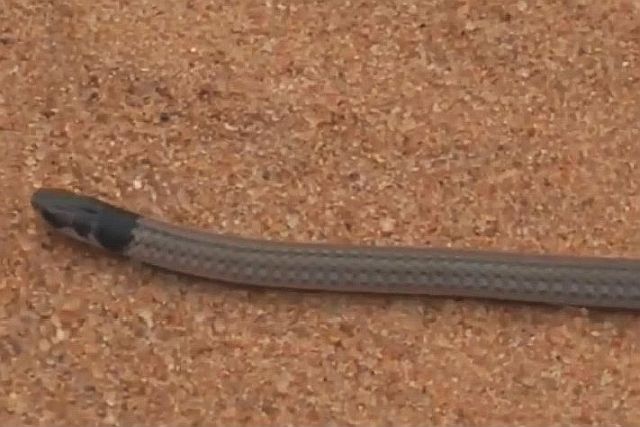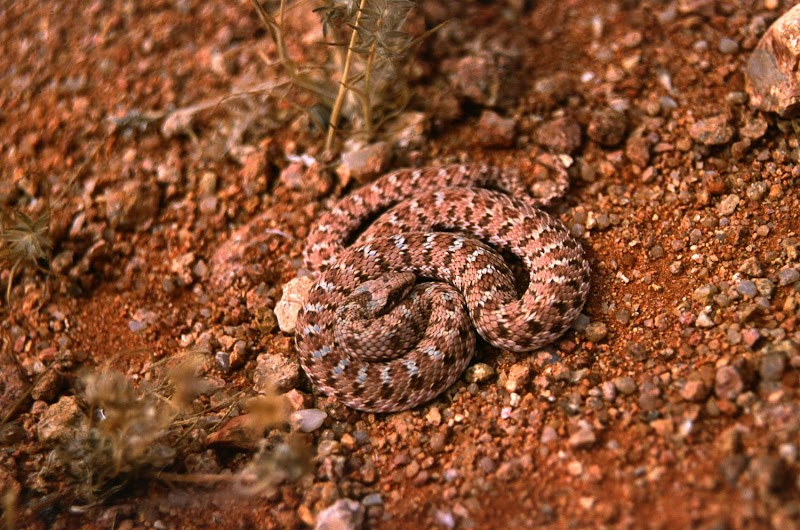Family Leptotyphloidae
The Leptotyphlopidae (commonly called slender blind snakes or thread snakes) are a family of snakes found in North America, South America, Africa, & Asia.
These primitive snakes are the smallest in the world with a maximum recorded total length of 40 cm but more typically attaining lengths of 15-20 cm. The body is cylindrical and very thin with a blunt head and a short tail. The scales are highly polished. Like other blindsnakes, they lack enlarged belly scales and have vestigial eyes (covered by scales). The highly flexible dentaries posses four or five teeth and they don't have teeth in the upper jaw.
Thread snakes live underground and follow the chemical trails of ants to their nests. They eat soft-bodied invertebrates, and have secretions that fool termites allow them to take up residence in termite nests and eat eggs and larvae. The pheromones they produce protect them from attack by termites. Their diets consist mostly of termite or ant larvae, pupae, and adults. Most species suck out the contents of insect bodies and discard the exoskeleton.
Leptotyphlopids are oviparous, laying up to 13 eggs per clutch. Female snakes have been observed coiled around their eggs, possibly demonstrating parental care.
Peters' Thread Snake Leptotyphlops scutifrons complex
Size: 18–24 cm.
These are the most widespread thread snakes in southern Africa, extending from Tanzania to KwaZulu-Natal.
They are the most confusing thread snakes, as numerous similar-looking species are involved, many still undescribed. They can be distinguished by the short tail (19–39 subcaudal scales) and wide rostral (about a third the width of the head at eye level). The tail ends abruptly in a spine. The body is uniformly black, but may turn silvery when dry.
They are usually found under logs or stones, but may be forced to the surface after heavy rains. Lays 3–7 elongate eggs in summer.
Africa Wild Reptile Book: Snakes - Photos & Descriptions
Moderator: Klipspringer
-
Klipspringer
- Global Moderator
- Posts: 5862
- Joined: Sat Sep 14, 2013 12:34 pm
- Country: Germany
- Contact:
- Lisbeth
- Site Admin
- Posts: 67396
- Joined: Sat May 19, 2012 12:31 pm
- Country: Switzerland
- Location: Lugano
- Contact:
Re: Africa Wild Reptile Book: Snakes - Photos & Descriptions
Black-Headed Centipede-Eater Aparallactus capensis
 © Klipspringer
© Klipspringer
A small slender snake that averages 30 cm with a maximum length of 40 cm. This common snake is usually found in deserted termite mounds or under logs and rocks where it is very common.
The Black-headed Centipede-eater is a specialist feeder and preys on centipedes – it will seize its prey and then chew along the body until the venom takes effect. The centipede is eaten head first.
A small slender snake that averages 30 cm with a maximum length of 40 cm. This common snake is usually found in deserted termite mounds or under logs and rocks where it is very common.
The Black-headed Centipede-eater is a specialist feeder and preys on centipedes – it will seize its prey and then chew along the body until the venom takes effect. The centipede is eaten head first.
"Education is the most powerful weapon which you can use to change the world." Nelson Mandela
The desire for equality must never exceed the demands of knowledge
The desire for equality must never exceed the demands of knowledge
-
Klipspringer
- Global Moderator
- Posts: 5862
- Joined: Sat Sep 14, 2013 12:34 pm
- Country: Germany
- Contact:
Re: Snakes - Pics & Descriptions
Eastern Tiger Snake Telescopus semiannulatus semiannulatus
Family Colubridae. Subfamily Colubrinae
Kruger National Park, Satara
Characteristics
• Head distinct from the body
• Large eyes (with vertical pupils)
• Orange-yellow colouration
• Strictly nocturnal lifestyle
• Highly aggressive nature when threatened
There are two subspecies of Telescopus semiannulatus
- Telescopus semiannulatus polystictus Mertens, 1954
- Telescopus semiannulatus semiannulatus Smith, 1849
The subspecies T. s. polystictus, Damara tiger snake, is found in the highveld of Namibia and northwest South Africa, has a more mottled appearance and more black bands (up to 75).
Description
A medium-sized, broad-headed, orange and black snake. This snake has an average length of 80 cm but can reach a length of 1 meter.
The eye is prominent, pupil vertical, iris orange or yellow. The tongue is pink. Neck very thin, body cylindrical or sub-triangular in section, tail 15–20% of total length.
Colour orange with 22 to 52 black, brown or dull rufous saddles all along the back.
Scalation
Scales smooth, in 17–21 rows at midbody, ventrals 190–244, subcaudals paired, 51–85 rows.
Geographical distribution
A South-east African species.
Habitat
Its favoured habitats include lowland forest and moist and arid savanna.
Behaviour
Nocturnal. It is an excellent climber and spends its days hiding under the bark of trees or under rocks. It can often be seen crossing roads at night.
Like the Herald snake, this snake puts up quite a show when cornered, drawing its head back with coiled neck and striking dramatically with an open mouth. The strikes are rather slow and the snake may lose its balance. It also flattens the head in the process but does not make a hood.
Diet
Feeds on lizards (particularly geckos), fledgling birds, bats and small rodents (e.g. mice).
Predators
Fed on by other snakes.
Reproduction
Oviparous (egg laying), lays between 3 and 20 eggs in summer.
Venom
The venom of this snake is very weak and has little or no effect on man.
Family Colubridae. Subfamily Colubrinae
Kruger National Park, Satara
Characteristics
• Head distinct from the body
• Large eyes (with vertical pupils)
• Orange-yellow colouration
• Strictly nocturnal lifestyle
• Highly aggressive nature when threatened
There are two subspecies of Telescopus semiannulatus
- Telescopus semiannulatus polystictus Mertens, 1954
- Telescopus semiannulatus semiannulatus Smith, 1849
The subspecies T. s. polystictus, Damara tiger snake, is found in the highveld of Namibia and northwest South Africa, has a more mottled appearance and more black bands (up to 75).
Description
A medium-sized, broad-headed, orange and black snake. This snake has an average length of 80 cm but can reach a length of 1 meter.
The eye is prominent, pupil vertical, iris orange or yellow. The tongue is pink. Neck very thin, body cylindrical or sub-triangular in section, tail 15–20% of total length.
Colour orange with 22 to 52 black, brown or dull rufous saddles all along the back.
Scalation
Scales smooth, in 17–21 rows at midbody, ventrals 190–244, subcaudals paired, 51–85 rows.
Geographical distribution
A South-east African species.
Habitat
Its favoured habitats include lowland forest and moist and arid savanna.
Behaviour
Nocturnal. It is an excellent climber and spends its days hiding under the bark of trees or under rocks. It can often be seen crossing roads at night.
Like the Herald snake, this snake puts up quite a show when cornered, drawing its head back with coiled neck and striking dramatically with an open mouth. The strikes are rather slow and the snake may lose its balance. It also flattens the head in the process but does not make a hood.
Diet
Feeds on lizards (particularly geckos), fledgling birds, bats and small rodents (e.g. mice).
Predators
Fed on by other snakes.
Reproduction
Oviparous (egg laying), lays between 3 and 20 eggs in summer.
Venom
The venom of this snake is very weak and has little or no effect on man.
-
Klipspringer
- Global Moderator
- Posts: 5862
- Joined: Sat Sep 14, 2013 12:34 pm
- Country: Germany
- Contact:
Re: Snakes - Pics & Descriptions
Dwarf Beak Snake Dipsina multimaculata
Family: Lamprophiidae.
 © PJL
© PJL

© PJL, Namibia
Description
A small, rear-fanged, diurnal terrestrial snake with a distinct, pointed snout. Adults may attain a total length of 40 cm, including a 4.5-cm tail. Average size 20–45cm.
It is pale buff or sandy gray dorsally, with three or five series of regular brown spots. The spots in the vertebral series are broader than long. A V-shaped brown mark is found on the back part of the head, with a diagonal brown streak from behind the eye towards the corner of the mouth. Ventrally, it is whitish.
Might be mistaken for a Horned Adder (Bitis caudalis). Note the hooked snout and C-shaped coils, which mimic a Horned Adder.
Scalation
The smooth dorsal scales are arranged in 17 rows. Ventrals number 155–168 in females, the anal plate is divided, and the subcaudals are divided (paired) into 31–40 in females.
Geographical distribution
It is found in southwestern Botswana, Namibia, and western and central South Africa.
Habitat
In semi-desert, dry savanna and rocky desert.
Diet
Feeds mainly on small lizards (lacertids and geckos).
Predators
Eaten by other snakes, birds of prey (particularly secretary birds and snake eagles) and small carnivorous mammals (e.g. mongooses).
Reproduction
Oviparous (egg-laying), lays between 2 and 4 eggs in midsummer.
Venom
Has a mild venom that has almost no effect on man.
Family: Lamprophiidae.
© PJL, Namibia
Description
A small, rear-fanged, diurnal terrestrial snake with a distinct, pointed snout. Adults may attain a total length of 40 cm, including a 4.5-cm tail. Average size 20–45cm.
It is pale buff or sandy gray dorsally, with three or five series of regular brown spots. The spots in the vertebral series are broader than long. A V-shaped brown mark is found on the back part of the head, with a diagonal brown streak from behind the eye towards the corner of the mouth. Ventrally, it is whitish.
Might be mistaken for a Horned Adder (Bitis caudalis). Note the hooked snout and C-shaped coils, which mimic a Horned Adder.
Scalation
The smooth dorsal scales are arranged in 17 rows. Ventrals number 155–168 in females, the anal plate is divided, and the subcaudals are divided (paired) into 31–40 in females.
Geographical distribution
It is found in southwestern Botswana, Namibia, and western and central South Africa.
Habitat
In semi-desert, dry savanna and rocky desert.
Diet
Feeds mainly on small lizards (lacertids and geckos).
Predators
Eaten by other snakes, birds of prey (particularly secretary birds and snake eagles) and small carnivorous mammals (e.g. mongooses).
Reproduction
Oviparous (egg-laying), lays between 2 and 4 eggs in midsummer.
Venom
Has a mild venom that has almost no effect on man.


